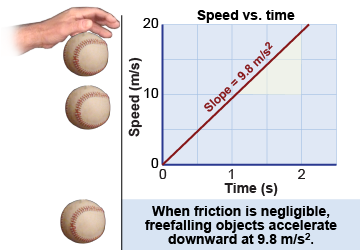|
Free fall is an idealized situation in which air friction is ignored and objects accelerate at a constant downward 9.8 m/s2. Free fall does not mean objects necessarily move down. If you throw a ball upward, the ball is in free fall the moment it leaves your hand because, once you are no longer touching it, gravity is the only force acting on the ball (neglecting friction). 
|
Free fall
|
 If friction is negligible, a falling object near Earth’s surface accelerates downward at a constant 9.8 m/s2, or “one g.” For example, after 3 s an object in free fall has a speed of 29.4 m/s, or nearly 66 mph! In real life, air friction typically becomes important at speeds greater than about 10 m/s. Smooth, compact objects such as marbles, however, really do accelerate at 9.8 m/s2 even when dropped several stories.
If friction is negligible, a falling object near Earth’s surface accelerates downward at a constant 9.8 m/s2, or “one g.” For example, after 3 s an object in free fall has a speed of 29.4 m/s, or nearly 66 mph! In real life, air friction typically becomes important at speeds greater than about 10 m/s. Smooth, compact objects such as marbles, however, really do accelerate at 9.8 m/s2 even when dropped several stories. 
|
The fact that a feather accelerates less than a falling stone was once explained by the hypothesis that heavier objects fall faster than light objects. Galileo critiqued this explanation through logic and was the first to explicitly realize that the true cause was air resistance. Galileo supposed that heavier objects did fall faster. Logically then, attaching a lighter object to a heavier one should hold the heavier object back somewhat, since the lighter object’s natural rate of falling is less. But at the same time, adding the lighter object makes the heavier object even heavier, so it should fall even faster still! Galileo correctly reasoned that this was absurd and concluded that the rate of falling must be the same for all objects regardless of weight. 
|
The conditions of free fall apply when objects move under the sole influence of gravity whether that motion is up, down, or sideways at any angle! You have probably heard the saying “what goes up must come down.” We can now calculate this. An object launched upward accelerates downward at 9.8 m/s2. If the ball is launched straight up, it comes straight back down. If the ball is launched at an angle, its velocity curves toward the ground by −9.8 m/s in the vertical direction every second. 
|

|
Acceleration due to gravity on the Moon is about 1/6 that of the Earth’s. Compared to on Earth, a ball thrown upward on the Moon will take __________ time to return to the surface. - more
- the same
- less
- not enough information
 |
Answer: A Because the acceleration due to gravity is lower on the moon, it will take longer for changes to occur to the ball's velocity. It will take longer for the ball to decelerate to zero velocity at the top of its path and it will gain less speed per second while falling, therefore taking longer to come down. 
|
| |
|

